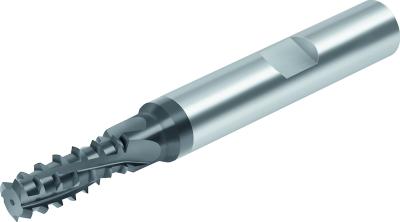
The Walter solid carbide TC620 Supreme universal thread milling cutter, with internal coolant, and a multi-row design delivers greater productivity through design innovations that permit less vibration, reduced cutting pressure and excellent dimensional accuracy.
The TC620 Supreme thread milling cutters utilize patent-pending Walter DeVibe technology with an anti-vibration land to effectively suppress vibrations and allow higher cutting parameters, while contributing to other TC620 Supreme advantages like a high level of process reliability and easy handling due to extremely infrequent radius correction. A low cost per thread is another advantage thanks to fast machining time and longer tool life. DeVibe significantly improves the surface quality, especially with fine threads, regardless of clamping conditions, varying cutting values or the milling strategy.
The multi-row design thread mills are available in UNC, UNF, M and MF threadforms. Specifically: UNC8-UNC 7/8, UNF10-UNF ¾, M4-M20 and MF4-MF20 with DeVibe offerings starting at 5/16 and 8mm in each group. These new solid carbide thread milling cutters employ high-performance WB10TJ grade with a specially blended AlTiN coating, allowing maximum performance in many different materials, including difficult-to-machine materials, even under unfavorable conditions, aided by internal coolant that provides reliable chip removal even at high feeds per tooth.
The Walter lineup of products consists of three categories to tools. Supreme indicates the highest level of technology and performance available Advance which indicates product efficiently balanced between price and performance and Perform tools are products that provide an economical solution with focused importance on price.
Contact Details
Related Glossary Terms
- coolant
coolant
Fluid that reduces temperature buildup at the tool/workpiece interface during machining. Normally takes the form of a liquid such as soluble or chemical mixtures (semisynthetic, synthetic) but can be pressurized air or other gas. Because of water’s ability to absorb great quantities of heat, it is widely used as a coolant and vehicle for various cutting compounds, with the water-to-compound ratio varying with the machining task. See cutting fluid; semisynthetic cutting fluid; soluble-oil cutting fluid; synthetic cutting fluid.
- gang cutting ( milling)
gang cutting ( milling)
Machining with several cutters mounted on a single arbor, generally for simultaneous cutting.
- land
land
Part of the tool body that remains after the flutes are cut.
- milling
milling
Machining operation in which metal or other material is removed by applying power to a rotating cutter. In vertical milling, the cutting tool is mounted vertically on the spindle. In horizontal milling, the cutting tool is mounted horizontally, either directly on the spindle or on an arbor. Horizontal milling is further broken down into conventional milling, where the cutter rotates opposite the direction of feed, or “up” into the workpiece; and climb milling, where the cutter rotates in the direction of feed, or “down” into the workpiece. Milling operations include plane or surface milling, endmilling, facemilling, angle milling, form milling and profiling.
- milling cutter
milling cutter
Loosely, any milling tool. Horizontal cutters take the form of plain milling cutters, plain spiral-tooth cutters, helical cutters, side-milling cutters, staggered-tooth side-milling cutters, facemilling cutters, angular cutters, double-angle cutters, convex and concave form-milling cutters, straddle-sprocket cutters, spur-gear cutters, corner-rounding cutters and slitting saws. Vertical cutters use shank-mounted cutting tools, including endmills, T-slot cutters, Woodruff keyseat cutters and dovetail cutters; these may also be used on horizontal mills. See milling.







